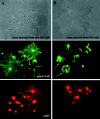The tripotential glial-restricted precursor (GRP) cell and glial development in the spinal cord: generation of bipotential oligodendrocyte-type-2 astrocyte progenitor cells and dorsal-ventral differences in GRP cell function
- PMID: 11756508
- PMCID: PMC6757619
- DOI: 10.1523/JNEUROSCI.22-01-00248.2002
The tripotential glial-restricted precursor (GRP) cell and glial development in the spinal cord: generation of bipotential oligodendrocyte-type-2 astrocyte progenitor cells and dorsal-ventral differences in GRP cell function
Abstract
We have found that the tripotential glial-restricted precursor (GRP) cell of the embryonic rat spinal cord can give rise in vitro to bipotential cells that express defining characteristics of oligodendrocyte-type-2 astrocyte progenitor cells (O2A/OPCs). Generation of O2A/OPCs is regulated by environmental signals and is promoted by platelet-derived growth factor (PDGF), thyroid hormone (TH) and astrocyte-conditioned medium. In contrast to multiple observations indicating that oligodendrocyte precursor cells in the embryonic day 14 (E14) spinal cord are ventrally restricted, GRP cells are already present in both the dorsal and ventral spinal cord at E13.5. Ventral-derived GRP cells, however, were more likely to generate O2A/OPCs and/or oligodendrocytes than were their dorsal counterparts when exposed to TH, PDGF, or even bone morphogenetic protein-4. The simplest explanation of our results is that oligodendrocyte generation occurs as a result of generation of GRP cells from totipotent neuroepithelial stem cells, of O2A/OPCs from GRP cells and, finally, of oligodendrocytes from O2A/OPCs. In this respect, the responsiveness of GRP cells to modulators of this process may represent a central control point in the initiation of this critical developmental sequence. Our findings provide an integration between the earliest known glial precursors and the well-studied O2A/OPCs while opening up new questions concerning the intricate spatial and temporal regulation of precursor cell differentiation in the CNS.
Figures





Similar articles
-
A tripotential glial precursor cell is present in the developing spinal cord.Proc Natl Acad Sci U S A. 1998 Mar 31;95(7):3996-4001. doi: 10.1073/pnas.95.7.3996. Proc Natl Acad Sci U S A. 1998. PMID: 9520481 Free PMC article.
-
Stage-specific effects of bone morphogenetic proteins on the oligodendrocyte lineage.J Neurobiol. 2000 Apr;43(1):1-17. J Neurobiol. 2000. PMID: 10756062
-
Embryonic-derived glial-restricted precursor cells (GRP cells) can differentiate into astrocytes and oligodendrocytes in vivo.Exp Neurol. 2001 Sep;171(1):11-21. doi: 10.1006/exnr.2001.7729. Exp Neurol. 2001. PMID: 11520117
-
Getting a GR(i)P on oligodendrocyte development.Dev Biol. 2004 Jan 1;265(1):33-52. doi: 10.1016/j.ydbio.2003.06.002. Dev Biol. 2004. PMID: 14697351 Review.
-
Redox state as a central modulator of precursor cell function.Ann N Y Acad Sci. 2003 Jun;991:251-71. doi: 10.1111/j.1749-6632.2003.tb07481.x. Ann N Y Acad Sci. 2003. PMID: 12846992 Review.
Cited by
-
PDGF alpha-receptor signal strength controls an RTK rheostat that integrates phosphoinositol 3'-kinase and phospholipase Cgamma pathways during oligodendrocyte maturation.J Neurosci. 2005 Apr 6;25(14):3499-508. doi: 10.1523/JNEUROSCI.5049-04.2005. J Neurosci. 2005. PMID: 15814780 Free PMC article.
-
Identification of two novel glial-restricted cell populations in the embryonic telencephalon arising from unique origins.BMC Dev Biol. 2007 Apr 17;7:33. doi: 10.1186/1471-213X-7-33. BMC Dev Biol. 2007. PMID: 17439658 Free PMC article.
-
Characterization of glial-restricted precursors from rhesus monkey embryonic stem cells.Transl Neurosci. 2015 Nov 27;6(1):244-251. doi: 10.1515/tnsci-2015-0026. eCollection 2015. Transl Neurosci. 2015. PMID: 28123809 Free PMC article.
-
Phenotypic analysis of astrocytes derived from glial restricted precursors and their impact on axon regeneration.Exp Neurol. 2012 Feb;233(2):717-32. doi: 10.1016/j.expneurol.2011.11.002. Epub 2011 Nov 10. Exp Neurol. 2012. PMID: 22101004 Free PMC article.
-
Stem and Progenitor Cell-Derived Astroglia Therapies for Neurological Diseases.Trends Mol Med. 2015 Nov;21(11):715-729. doi: 10.1016/j.molmed.2015.09.003. Epub 2015 Oct 3. Trends Mol Med. 2015. PMID: 26443123 Free PMC article. Review.
References
-
- Avossa D, Pfeiffer SE. Transient reversion of O4+GalC− oligodendrocyte progenitor development in response to the phorbol ester TPA. J Neurosci Res. 1993;34:113–128. - PubMed
-
- Bansal R, Washington AE, Gard AL, Pfeiffer SE. Multiple and novel specificities of monoclonal antibodies O1, O4, and R-mAb used in the analysis of oligodendrocyte development. J Neurosci Res. 1989;24:548–557. - PubMed
-
- Barnett SC, Hutchins AM, Noble M. Purification of olfactory nerve ensheathing cells from the olfactory bulb. Dev Biol. 1993;155:337–350. - PubMed
-
- Baroffio A, Dupin E, Le Douarin NM. Common precursors for neural and mesectodermal derivatives in the cephalic neural crest. Development. 1991;112:301–305. - PubMed
-
- Barth KA, Kishimoto Y, Rohr KB, Seydler C, Schulte-Merker S, Wilson SW. Bmp activity establishes a gradient of positional information throughout the entire neural plate. Development. 1999;126:4977–4987. - PubMed
Publication types
MeSH terms
Substances
Grants and funding
LinkOut - more resources
Full Text Sources
Other Literature Sources
Medical
